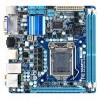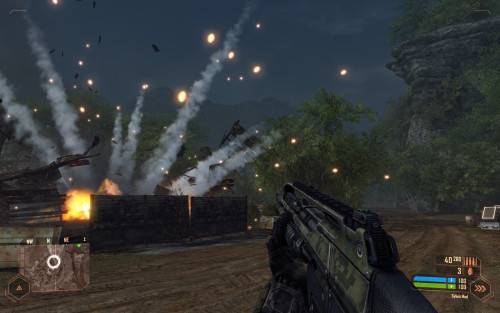- Qualcomm Launches Snapdragon 4 Gen 2 Mobile Platform
- AMD Launches Ryzen PRO 7000 Series Mobile & Desktop Platform
- Intel Launches Sleek Single-Slot Arc Pro A60 Workstation Graphics Card
- NVIDIA Announces Latest Ada Lovelace Additions: GeForce RTX 4060 Ti & RTX 4060
- Maxon Redshift With AMD Radeon GPU Rendering Support Now Available
Gigabyte H55N-USB3 – Big Features, Small Package

Some might say that “bigger is better”, but when it comes to today’s PCs, that doesn’t have to be the case. Rather, you can easily build a feature-rich and high-performance PC that can be entirely hidden from view. Mini-ITX motherboards exist to help with that, and where those are concerned, Gigabyte’s H55N-USB3 is well-worth looking out for.
Page 8 – Gaming: CoD: Modern Warfare 2, Crysis Warhead, 3DMark Vantage
When the original Call of Duty game launched in 2003, Infinity Ward was an unknown. Naturally… it was the company’s first title. But since then, the series and company alike have become household names. Not only has the series delivered consistently incredible gameplay, it’s pushed the graphics envelope with each successive release, and where Modern Warfare is concerned, it’s also had a rich storyline.
The first two titles might have been built on the already-outdated Quake III engine, but since then, the games have been built with improved graphical features, capable of pushing the highest-end PCs out there. Modern Warfare 2 is the first such exception, as it’s more of a console port than a true PC title. Therefore, the game doesn’t push PC hardware as much as we’d like to see, but despite that, it still looks great, and lacks little in the graphics department. You can read our review of the game here.
The level chosen is the 10th mission in the game, “The Gulag”. Our teams fly in helicopters up to an old prison with the intention of getting closer to finding the game’s villain, Vladimir Makarov. Our saved game file begins us at the point when the level name comes on the screen, right before we reach the prison, and it ends after one minute of landing, following the normal progression of the level. The entire run takes around two-and-a-half minutes.

Crysis Warhead
As PC enthusiasts, we tend to be drawn to games that offer spectacular graphics… titles that help reaffirm your belief that shelling out lots of cash for that high-end monitor and PC was well worth it. But it’s rare when a game comes along that is so visually-demanding, it’s unable to run fully maxed out on even the highest-end systems on the market. In the case of the original Crysis, it’s easy to see that’s what Crytek was going for.
Funny enough, even though Crysis was released close to a year ago, the game today still has difficulty running at 2560×1600 with full detail settings – and that’s even with overlooking the use of anti-aliasing! Luckily, Warhead is better optimized and will run smoother on almost any GPU, despite looking just as gorgeous as its predecessor, as you can see in the screenshot below.
The game includes four basic profiles to help you adjust the settings based on how good your system is. These include Entry, Mainstream, Gamer and Enthusiast – the latter of which is for the biggest of systems out there, unless you have a sweet graphics card and are only running 1680×1050. We run our tests at the Gamer setting as it’s very demanding on any current GPU and is a proper baseline of the level of detail that hardcore gamers would demand from the game.

Futuremark 3DMark Vantage
Although we generally shun automated gaming benchmarks, we do like to run at least one to see how our GPUs scale when used in a ‘timedemo’-type scenario. Futuremark’s 3DMark Vantage is without question the best such test on the market, and it’s a joy to use, and watch. The folks at Futuremark are experts in what they do, and they really know how to push that hardware of yours to its limit.
The company first started out as MadOnion and released a GPU-benchmarking tool called XLR8R, which was soon replaced with 3DMark 99. Since that time, we’ve seen seven different versions of the software, including two major updates (3DMark 99 Max, 3DMark 2001 SE). With each new release, the graphics get better, the capabilities get better and the sudden hit of ambition to get down and dirty with overclocking comes at you fast.
Similar to a real game, 3DMark Vantage offers many configuration options, although many (including us) prefer to stick to the profiles which include Performance, High and Extreme. Depending on which one you choose, the graphic options are tweaked accordingly, as well as the resolution. As you’d expect, the better the profile, the more intensive the test.
Performance is the stock mode that most use when benchmarking, but it only uses a resolution of 1280×1024, which isn’t representative of today’s gamers. Extreme is more appropriate, as it runs at 1920×1200 and does well to push any single or multi-GPU configuration currently on the market – and will do so for some time to come.


Like the vast majority of our benchmarks throughout this review, neither motherboard totally overcomes the other in terms of performance, and gaming isn’t much different.
Support our efforts! With ad revenue at an all-time low for written websites, we're relying more than ever on reader support to help us continue putting so much effort into this type of content. You can support us by becoming a Patron, or by using our Amazon shopping affiliate links listed through our articles. Thanks for your support!








